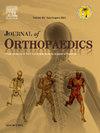Body mass index does not increase risk of complications after reverse total shoulder arthroplasty
IF 1.5
Q3 ORTHOPEDICS
引用次数: 0
Abstract
Introduction
As obesity rates continue to rise in the United States, understanding the long-term impact of body mass index (BMI) on outcomes following reverse total shoulder arthroplasty (rTSA) is increasingly important. While prior studies have yielded conflicting results, limited data exist on functional outcomes beyond five years postoperatively.
Methods
We conducted a retrospective study of 50 shoulders that underwent primary rTSA by a single surgeon, with a mean follow-up of 6.7 years. Patients were stratified into two groups based on BMI: <30 (n = 37) and ≥30 (n = 13). Demographics, range of motion (ROM), patient-reported outcome measures (PROMs), and implant survival were compared between groups. Statistical analyses included t-tests, χ2 tests, Pearson correlations, and Kaplan-Meier survival estimates.
Results
Both BMI cohorts experienced significant improvements in ROM and PROMs postoperatively. Forward elevation improved from 81.3° to 133.5° (p < .01), and VAS pain scores decreased from 6.1 to 1.7 (p < .01). There were no statistically significant differences between BMI groups in final ROM, ASES, SST, or VAS scores. Implant survival was similar between groups. No significant correlations were found between BMI and long-term functional outcomes.
Conclusion
BMI does not significantly affect long-term clinical or functional outcomes following rTSA. Despite higher BMI posing potential perioperative challenges, obese patients can achieve comparable improvements in pain, ROM, and quality of life. These findings support the efficacy of rTSA across BMI categories when appropriate perioperative care is provided.
体重指数不会增加逆行全肩关节置换术后并发症的风险
随着美国肥胖率的持续上升,了解体重指数(BMI)对反向全肩关节置换术(rTSA)后预后的长期影响变得越来越重要。虽然先前的研究产生了相互矛盾的结果,但关于术后5年以上的功能结果的数据有限。方法:我们对50例由同一位外科医生接受原发性rTSA的肩部进行了回顾性研究,平均随访时间为6.7年。患者根据BMI分为两组:<;30 (n = 37)和≥30 (n = 13)。比较两组人口统计学、活动度(ROM)、患者报告的结果测量(PROMs)和种植体存活率。统计分析包括t检验、χ2检验、Pearson相关性和Kaplan-Meier生存估计。结果两组BMI患者术后ROM和prom均有显著改善。前仰角从81.3°提高到133.5°(p <;.01), VAS疼痛评分从6.1降至1.7 (p <;. 01)。BMI组之间的最终ROM、as、SST或VAS评分无统计学差异。各组间种植体存活率相似。BMI和长期功能结果之间没有明显的相关性。结论bmi对rTSA术后的长期临床或功能结局无显著影响。尽管较高的BMI会给围手术期带来潜在的挑战,但肥胖患者在疼痛、ROM和生活质量方面可以取得相当的改善。这些发现支持在提供适当的围手术期护理的情况下,rTSA在不同BMI类别中的有效性。
本文章由计算机程序翻译,如有差异,请以英文原文为准。
求助全文
约1分钟内获得全文
求助全文
来源期刊

Journal of orthopaedics
ORTHOPEDICS-
CiteScore
3.50
自引率
6.70%
发文量
202
审稿时长
56 days
期刊介绍:
Journal of Orthopaedics aims to be a leading journal in orthopaedics and contribute towards the improvement of quality of orthopedic health care. The journal publishes original research work and review articles related to different aspects of orthopaedics including Arthroplasty, Arthroscopy, Sports Medicine, Trauma, Spine and Spinal deformities, Pediatric orthopaedics, limb reconstruction procedures, hand surgery, and orthopaedic oncology. It also publishes articles on continuing education, health-related information, case reports and letters to the editor. It is requested to note that the journal has an international readership and all submissions should be aimed at specifying something about the setting in which the work was conducted. Authors must also provide any specific reasons for the research and also provide an elaborate description of the results.
 求助内容:
求助内容: 应助结果提醒方式:
应助结果提醒方式:


